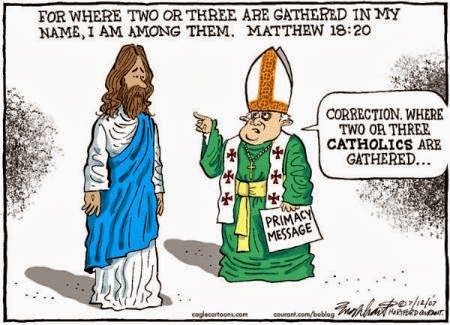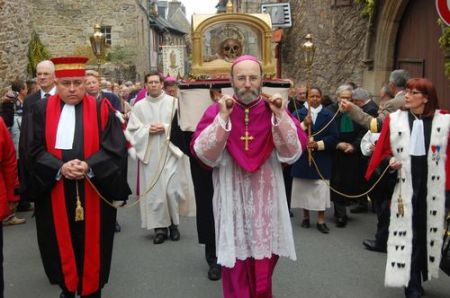The Holy Bones of the First Holy Father
What sort of religion keeps dead people’s bones, puts them on display, and expects people to kiss them? Catholicism - and it's awesome.

Fr Dwight Longenecke
What sort of religion keeps dead people’s bones, puts them on display, and expects people to kiss them? This weekend’s news reminds the world that the veneration of relics is still very much part of the Catholic faith. As a fitting climax to the Year of Faith, Pope Francis put on display for the first time the bones of St. Peter, the first Pope.
The news headlines focused on the sensational, and many journalists asked the obvious questions, often missing the point and skimming over the facts to report superficially. There are some excellent questions that arise from the reports of St. Peter’s bones being produced: What are relics and why are they important to Catholics? Why do Catholics kiss the bones of dead people? Are Catholics really so gullible as to believe in the authenticity of relics (we know they’re fake, right)? Could those bone fragments really be the remains of Peter the Apostle?
A relic is anything associated with a person who has been canonized as a saint or beatified as blessed. There are three categories of relics: a first class relic is some part of the person’s mortal remains. The relic could be a fragment of bone, hair, skin, or blood. The relic is taken when the body of the saint is exhumed as part of the canonization process.

A second class relic is some object or part of an object which was regularly used or worn by the saint during their earthly life. There are many second class relics. These might include the saint’s belongings, clothing, furniture or a part of these things. Second class relics of Pope John Paul II, for example, include scraps of his clothing, or pieces of his belongings.

A third class relic is a piece of cloth that has touched a first class relic. Third class relics are typically included as parts of mass produced prayer cards and items of devotion. A cloth will be touched to the first class relic, then cut up into many pieces so a large number of people can have physical contact with the saint.

A relic is “venerated” by either kissing it or kissing one’s fingers and touching the relic. This is done as part of religious services honoring the saint. Catholics believe that the physical world matters. When a person becomes holy, everything about them is touched by that holiness. Holiness permeates even the physical world.
Veneration of the saints began in the early church. When Christians were martyred, their remains were gathered up and honored. In 156 AD, the Christians in the city of Smyrna recorded what they did with the remains of their beloved bishop Polycarp, who had been killed: “We took up his bones, which are more valuable than precious stones and finer than refined gold, and laid them in a suitable place, where the Lord will permit us to gather ourselves together, as we are able, in gladness and joy and to celebrate the birthday of his martyrdom.”
The custom of honoring the saintly dead began by producing their remains on the anniversary of their death. From those earliest days of the faith, Catholics have honored the saintly dead by venerating their mortal remains.
Are Catholics gullible to believe in relics? Not really. We assess the authenticity of relics as we would any historical claim. Some relics are fake; others are definitely genuine. The veracity of others still remains uncertain. For a relic to be venerated publicly, the owner must have official documentation called an “authentic.” The authentic is produced by the bishop when the relics are produced. The authentic can be checked by experts to ensure that it is genuine.
What about the relics of St. Peter that were displayed this weekend? The story of their discovery is a fascinating piece of detective work. We know that the great Basilica of St. Peter stands on what was once the side of the Vatican Hill. In the first century, that hill was the location of a cemetery. In the mid-fourth century, the Emperor Constantine commanded his engineers to carve away part of the hill and dump the infill to create a level platform on which to build a church. Constantine went to all that trouble so that his church might be centered on a particular tomb in the Vatican Hill cemetery. For three centuries, that tomb had been honored by Roman Christians as the tomb of St Peter.
Several centuries later, when archeologists began digging beneath St. Peter’s Basilica in the 1940s, they discovered the cemetery; therein, just below the high altar, they discovered a second century monument that was built over a pauper’s grave from the first century. Within it, they found some bones wrapped in a purple silk cloth. Carved on the side of the monument were the words, “Here is Peter.” Examination of the bones revealed them to be of a stocky man who died in his sixties – the approximate age of the apostle when he died in the persecutions of Nero in 65 AD. The skeleton was incomplete – it had no feet. The ancient stories say that Peter was crucified upside down. Historians surmise that his followers may have removed the saint’s body from the cross hurriedly by cutting off the feet.
Are the bones displayed this weekend the bones of St. Peter? We will never know for sure because we can’t conduct a DNA test on his relatives. Debate continues, and Vatican spokesman Father Federico Lombardi remained cautious. He said presentation of the relics was “a way to feel spiritually close to the story of the tomb and of the apostle. There is a serious possibility they are St. Peter’s bones, but we don't go beyond that". When all the evidence is pieced together, we can affirm with great probability that the bones of a stocky man in his sixties found in the grave below the high altar of St. Peter’s Basilica are the 2,000 year old remains of the man who Jesus Christ called to leave his nets and be a fisher of men.
The fact that the greatest church in Catholicism stands majestically on the grave of St. Peter is an awesome reminder that Jesus not only called Peter to be a fisher of men, but he also declared that Peter was the rock on whom he would build his Church.
For complete information about the relics, check out this article from the Catholic Answers website.
6.000 Roman Catholics bow before a piece of flesh

Archbishop Mark Davies of Shrewsbury pray in front of a piece of flesh, when youth teens see conduct and compare with the Acts of the apostles they can tell that this is paganism
By accepting “allah”, you reject the divinity of Jesus the Messiah.


The skull is kept safely inside the Church in France.

Roman Catholic chapel in Poland with 24.000 skulls and skeletons
October 4, 2013Hundreds of skulls have been put up around this alter with a crucifix. This place is a Vatican approved chapel.

Cameron Cole, youth director at Cathedral Church of the Advent in Birmingham, Ala., says, "There is a propensity in our culture to outsource the development of our children. For intellectual development, we send them to school. For athletic development, we send them to Little League. And for spiritual formation, we send them to youth group. The church has done a poor job of communicating to the parents that they are the primary disciplers of their children. Parents don't believe this, but the reality is that kids listen to their parents far more than they're going to listen to a youth minister."
UgandaCatholics Praying-at-Monsignor-Aloysius-Ngobya’s-grave
The Biblical Truth About Saints And Sainthood
http://watchmanafrica.blogspot.com/2013/06/the-biblical-truth-about-saints-and.htmlCatholics struggle to touch Monsignor-Aloysius-Ngobya’s coffin in order to get blessings
Catholics struggle to touch the statues of catholic Martyrs who were declared saints by Rome
Catholics Pilgrims pray at Charles Lwanga’s statue during the vigil of Uganda Martyrs’ Day in Namugongo. PHOTO BY Abubaker Lubowa
Their throat is an open sepulchre; with their tongues they have used deceit; the poison of asps is under their lips: (Romans 3:13)
Well hath Esaias prophesied of you hypocrites, as it is written, This people honoureth me with their lips, but their heart is far from me. Howbeit in vain do they worship me, teaching for doctrines the commandments of men.(Mark 7:6-7)
Let them alone: they be blind leaders of the blind. And if the blind lead the blind, both shall fall into the ditch. (Matthew 15:4)
Catholic priests worship corpse of Saint Ubaldo
http://ivarfjeld.com/2013/07/27/catholic-priests-worship-corpse-of-saint-ubaldo/
The corpse of St. Ubaldo is kept in St Ubaldo Basilica, a Franciscan Cloister in Gubbio in Italy.Their throat is an open sepulchre; with their tongues they have used deceit; the poison of asps is under their lips: (Romans 3:13)
Well hath Esaias prophesied of you hypocrites, as it is written, This people honoureth me with their lips, but their heart is far from me. Howbeit in vain do they worship me, teaching for doctrines the commandments of men.(Mark 7:6-7)
Let them alone: they be blind leaders of the blind. And if the blind lead the blind, both shall fall into the ditch. (Matthew 15:4)

The cut out heart of a Roman Catholic priest.




